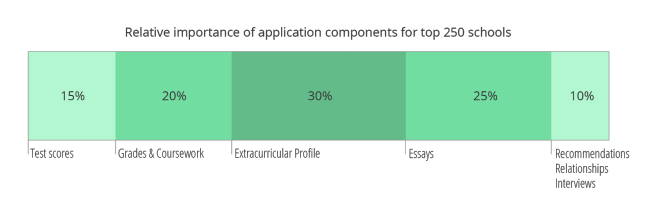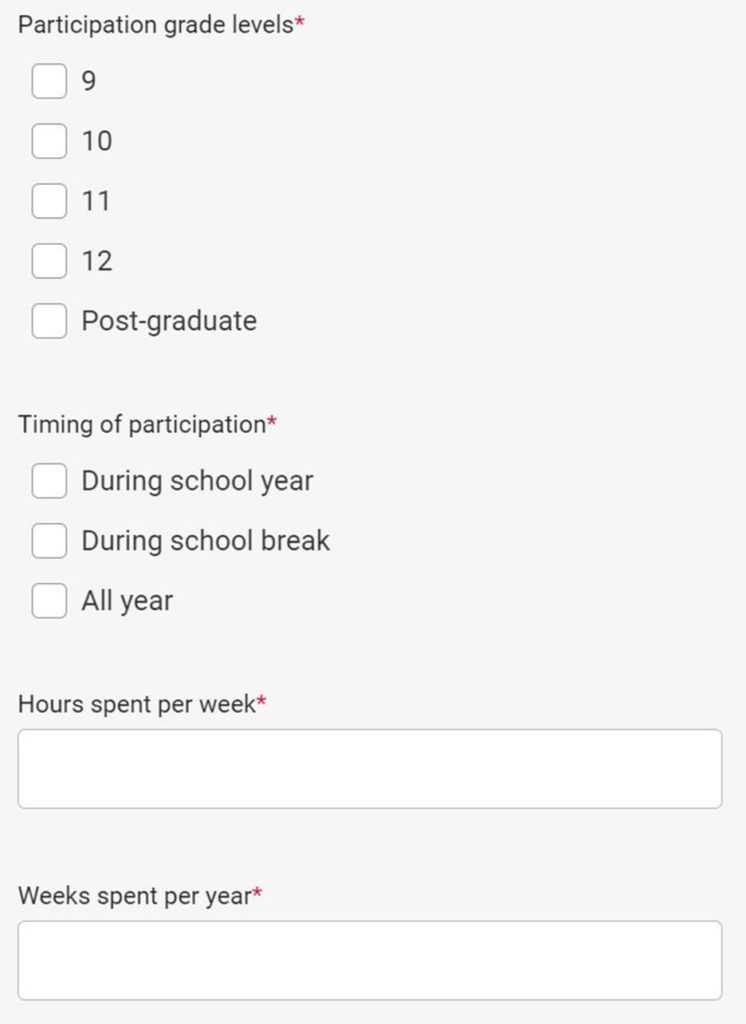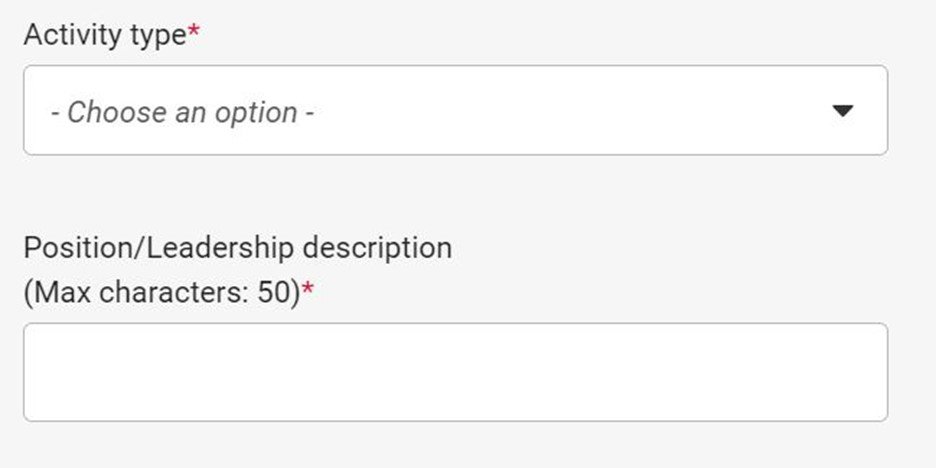How to Fill Out the Common App Activities Section

Your GPA and SAT don’t tell the full admissions story
Our chancing engine factors in extracurricular activities, demographics, and other holistic details. We’ll let you know what your chances are at your dream schools — and how to improve your chances!
Calculate your acceptance chancesYour GPA and SAT don’t tell the full admissions story
Our chancing engine factors in extracurricular activities, demographics, and other holistic details. We’ll let you know what your chances are at your dream schools — and how to improve your chances!
Calculate your acceptance chancesWhat’s Covered:
- How Important is the Activities Section?
- Types of Activities and Positions Held
- Selecting Activities to Include
- Position/Leadership Description
- Writing the Description
- Participating Grade Levels
- Estimating Time Commitment
- Participation in College
Filling out the Common App can be a very involved process. There are so many sections to go through, and it seems overwhelming at times. This article provides you with step by step instructions, as well as do’s and don’ts for each section, that will help you break down the activities section of the Common App.
How Important is the Activities Section?

Selective colleges use grades and test scores to filter out applicants, but once you get past that initial stage, extracurriculars make up about 30% of your admissions decision. This shows us that they’re almost as important as academics! Since there are many applicants with similar academic backgrounds, colleges use extracurriculars to help them differentiate and choose between applicants. For more information about how colleges filter applicants, check out our post on the Academic Index.
While extracurriculars might seem subjective, colleges are methodical in their evaluation of them. They use the 4 Tiers of Extracurriculars:
Tier 1: These are rare activities that show exceptional achievement or leadership. They include national awards or other prestigious achievements.
Tier 2: These are little more common than Tier 1, but these activities still showcase high levels of achievement and leadership. They include top leadership positions for well-known clubs and organizations, winning regional competitions, or state-level sports/music distinctions.
Tier 3: These lack the distinction of Tier 1 and 2, but still highlight student’s interests. They include minor leadership positions for well-known clubs and organizations and smaller athletic/musical distinctions.
Tier 4: These are the most common activities and are seen most often by admissions committees. They include general club/sports/musical membership and general volunteering.
If you’re wondering where your extracurriculars fall within the tier system, check out our free Chancing Engine. We’ll let you know if your profile is competitive for your dream schools and give you tips on improving your profile!
Types of Activities and Positions Held

The Common Application offers a drop-down menu with the following activities from which to select:
- Academic
- Art
- Athletics: Club
- Athletics: JV/Varsity
- Career-Oriented
- Community Service (Volunteer)
- Computer/Technology
- Cultural
- Dance
- Debate/Speech
- Environmental
- Family Responsibilities
- Foreign Exchange
- Journalism/Publication
- Junior R.O.T.C.
- LGBT
- Music: Instrumental
- Music: Vocal
- Religious
- Research
- Robotics
- School Spirit
- Science/Math
- Student Gov.t./Politics
- Theater/Drama
- Work (paid)
- Other Club/Activity
For each activity you include on your application, choose the appropriate category. If you find that a particular extracurricular activity fits into multiple categories, choose the more specific one (e.g. “Math Club” would go into “Science/Math as opposed to Academic”). If the activity fits into two equally specific categories, choose the more relevant one. You will be able to expand in the description if needed.
Since the list is fairly broad, you will probably find that your activity fits into at least one of the sections available. If not, select “Other Club/Activity” and identify it in the “Position/Leadership” description and organization name section. In this case, unless the position and organization names are fairly self-explanatory or very recognizable, you will need to be a bit more specific in your description.
While many of these extracurricular activities are fairly general, such as “Academic” and “School Spirit,” a few of them refer to specific positions or organizations. “Junior R.O.T.C.”, for example, refers to Junior Reserve Officer Training Corps, a Federal Program sponsored by the U.S. Armed Forces. Accordingly, you should only list that activity if you actually participate in that specific organization.
Colleges do want to see that you are specialized, but you probably don’t want to choose the same category for every activity. If it seems like you are choosing one category for everything, try to diversify a bit and think about how activities can be related without being exactly the same thing.
For example, if you are the secretary in student government and participated in a leadership program over the summer, select “Student Government/Politics” for the secretary position, and “Career-Oriented” for the leadership program. Both categories indicate that you are a driven leader, but they present different facets of your personality.
Selecting Activities to Include
The activities section has a limit of ten extracurricular activities. The restrictions mean you will need to be selective in reporting your activities, limiting you to the most important ones or those that are most meaningful to you. If you need to add more activities, use the additional information section or your essays. However, you should only do so if these activities are truly essential to the admissions committee’s understanding of your extracurricular life.
Many schools allow you to submit a resume in addition to your application. Not only does doing so allow you to include more extracurricular activities, but also provides more space for you to expand on the descriptions of your activities since you are not limited to a certain number of characters.
Also, remember that you don’t have to list ten activities just because the space is available; some require much more of a commitment than others, so it’s okay if you only have 5 activities that are time intensive and mean a lot to you.
For each activity, the form will ask you in which grade levels you participated in the extracurricular activity, the timing of your participation (school year vs. school break), and how many hours you spent on it per week and weeks per year.

These questions can help you narrow down which activities to include, since you should only be adding the ones to which you are truly dedicated. Colleges want to see that you’re committed to your activities because that indicates a passion for something outside of academics that you will bring to college and hopefully beyond.
For example, if you played tennis all four years of high school and became captain of your school team senior year, that is an activity to include in this section. On the other hand, if you dabbled in the clarinet briefly in ninth grade before quitting, it’s probably a good idea to skip that one, unless you don’t have a lot of activities to list.
There may be some activities that are naturally limited to a set time period or commitment, such as a summer academic program or sports camp. Colleges won’t see the brevity of your involvement as a negative factor; they understand that some activities simply have an imposed beginning and ending that are not within your control.
You will have a chance to indicate the timing of the activity — during school year, school break, or all year — and colleges will take that into consideration when evaluating the activity. Additionally, if you have participated in related activities, colleges will see the pattern of your interest and commitment.
Position/Leadership Description and Organization Name

After you choose the activity type, the application will ask you to describe the position you held (or hold) and the organization name. This section is limited to 50 characters.
Be as specific as possible here. If you participate in a club, define your role, rather than just listing “member.” If you participated in an activity for multiple years and have had multiple roles within it, list your roles in order of importance rather than chronologically. For example, if you were Student Council Vice President freshman year and a class representative the other three years, list these out as: Vice President (1 yr), Class Representative (3 yrs).
You should also be specific in defining the organization. If it has a name, say it, and define what it is if that is unclear. If the activity is typically referred to by an acronym, be sure to list the full name, as you never want to assume that admissions committees will be familiar with the activity to which you are referring.
Writing the Description

You are limited to 150 characters for details, accomplishments, honors won, and accomplishments within each activity, so you will need to be concise and offer only the most pertinent details. If you absolutely need more room to thoroughly explain truly important details about the activity, use the additional information section to expand, or describe it in more detail in your essay if it relates to the topic you choose.
Remember that this section is not there for you to prove your eloquence as a writer; you have the essay to do that. Rather, this serves to inform the admissions committee about your life outside school as succinctly as possible. Use active verbs and limit the use of adjectives and adverbs. You don’t need to use complete sentences. Be as specific as you can be in the space available. If you hold a leadership position, emphasize that role in your description.
Try to focus on quantitative descriptions over qualitative ones. Adding numerical values offers concrete proof of your success, and can show colleges how you were involved specifically. If you are a leader in the activity, mention how many members the group has, how many people you serve (if applicable), how many people your work affected, and so on.
Try not to be redundant, especially considering the limited space. For instance, if you are the president of the tutoring club at your school, you don’t need to list “tutoring” in the description, since colleges are likely to consider that a given; instead, emphasize your duties as president, how you manage and distribute tasks and how you work with club members. If you want to talk about the actual tutoring in more detail, discuss your approach — e.g., “Meet with students one-on-one, develop study aids, and create practice examples.”
Examples:
Example 1:
Editor, The Daily (school newspaper)
Run weekly meetings, brainstorm topics, assign and revise 10 articles/week, collaborate with printers to distribute 500 copies to students and faculty.
Example 2:
Goalkeeper, Varsity Field Hockey (school team)
2018 conference champions; led weekly trainings for the JV goalkeepers; organized team bonding events.
Example 3:
Concert master (school orchestra)
Member of most advanced ensemble, led sectionals to teach difficult passages, performed five concerts per year.
Example 4:
Service Club President and co-founder
Chapter of club at high school; participated in toy and food drives, raised $1000 for refugees, made 200 cards and blankets for children in hospitals.
Example 5:
Science Olympiad school team member
Participated in multiple science-based events; 2nd place 2018 for Write It Do It, 3rd place 2019 for Meteorology.
Example 6:
Model UN school team member
Participated in three conferences per year; Best Small Delegation 2018, Outstanding Delegate 2019.
These are examples of strong activity descriptions because they provide a large amount of information in a few words. College admissions officers don’t have the time to read large blocks of text, and it’s generally better to try and write less in areas where they are not asking for an essay.
An example of a weaker response would be:
Position: Hospital Volunteer
Description: Helped patients and doctors.
This example does not elaborate on what the student did, nor does it show what they learned from their time at the hospital. Instead, they could say something like: entertained children in the waiting room by sharing riddles and performing “mathemagics”; fully digitized the patient filing system.
If you’re have trouble figuring out how to word your activity descriptions, here is a table of action words that you can use:
|
achieved |
demonstrated |
facilitated |
managed |
projected |
|
analyzed |
designed |
improved |
organized |
redesigned |
|
authored |
developed |
initiated |
overhauled |
remodeled |
|
coordinated |
directed |
integrated |
oversaw |
researched |
|
delegated |
executed |
led |
prioritized |
trained |
Participating Grade Levels

The application will ask you in which grade levels you participated in a particular activity. The key is as follows:
9-12: High School Grades
Post-graduate: After High School
If you participated in an activity over the summer between grade levels, choose the rising or later grade level (e.g., the summer between 10th and 11th grades should be listed as “11th grade”).
Estimating Time Commitment

When you estimate the amount of time you spent on a particular activity, it doesn’t need to be exact. However, it does need to be realistic. If you claim to spend ten hours per week on all ten activities, colleges will know you’re exaggerating, to say the least. It’s understandable that you spend more time on some activities than others.
If you are having trouble estimating your time commitment, try keeping a time log for a couple weeks and provide an average.
Participation in College

The last question for each activity asks you whether or not you plan to continue a similar extracurricular activity in college. The application asks this because colleges want to know what kind of student you will be when you arrive. Remember, they are looking for a diverse student body filled with future leaders in their respective fields. If you intend to continue a particular pursuit in college, it shows them that you are truly interested and dedicated to it. To some degree, they also want to see that you are doing the activity because you are truly passionate about it, not just because you want to impress colleges.
That doesn’t mean you have to continue it. Some activities have a natural end and simply aren’t adaptable to a college environment, such as a club particular to your high school. Or perhaps you just don’t want to continue it. But if it is something you don’t really care about, you may want to reevaluate whether or not it is a good idea to include it in your application.
Also keep in mind that just because you intend to continue the activity in college at this point does not mean you are obligated to do so when you actually matriculate. Colleges may give your name to members of a club, organization, or activity in which you participate so they can follow up with you, but you are by no means bound to joining when you begin college (unless, of course, you are accepted on an athletic or other scholarship that requires your participation in a certain activity). So by answering “yes” to this question, you are merely indicating that you are interested in continuing the activity.
A Few Other Considerations
List your activities in order of importance. To delete an activity, move it to the bottom of the list and click on the delete icon. You can also simply edit the activity to reflect a different one.
You may want to start by watching the short tutorial video available at the top of the section to get started. Try not to feel too overwhelmed — college applications take a lot of work, but the reward is well worth it.




